Text Processing
Description
This action block is for various text manipulations. For example: processing scraped text, cleaning up garbage, or even translating it to another language – all this and much more is what this "cube" can do.
How to add to your project?
Right-click and select Add Action → Data → Text Processing:
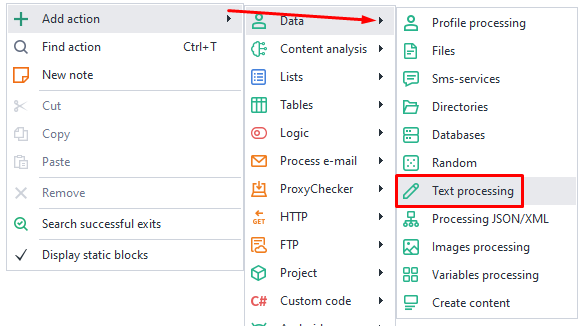
What the action block looks like
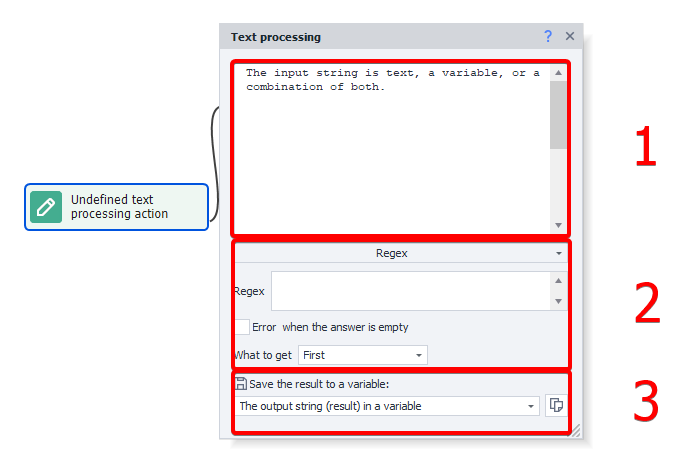
The window is split into three sections:
1. Input string. Here you can put text, a variable, or a combination of them.
2. Actions to perform on the string, with settings.
3. Output string where your result is saved to a variable.
If you put the cursor in the input field and press Ctrl+Space, you'll see a dropdown with useful constants and project variables.
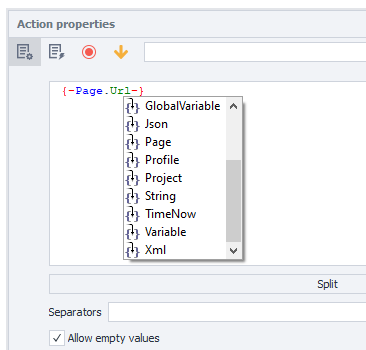
String Escape (Escaping Characters)
This action escapes spaces and these characters: * + ? | { [ ( ) ^ . #. In other words, it adds a slash \ before each of those symbols.
This is often used for query processing. It also helps the regular expression handler see characters as literals, not as commands or metacharacters.
Regex (Text Processing with Regular Expressions)
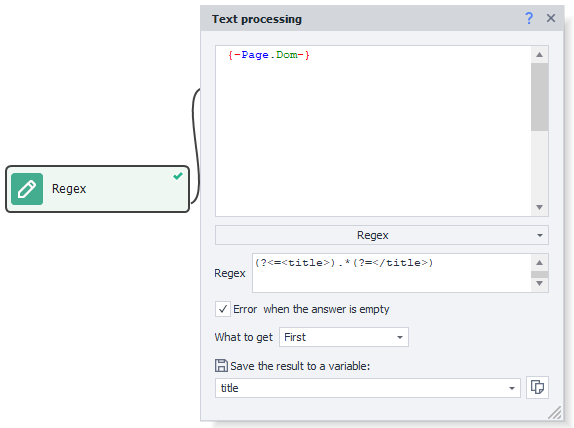
Regular expressions are super handy for parsing strings according to a specific pattern. This action can get not just the first matching value, but the whole group, and save the values to variables or a table.
Regex Input Field
This is where you enter your regular expression to search the text. Example: (?<=<title>).*(?=</title>).
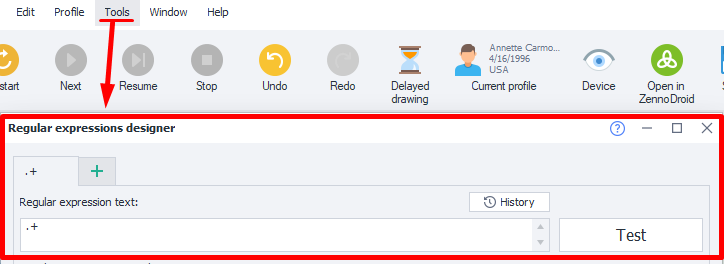
Error when the answer is empty
If this option is enabled, the action will return an error if the regular expression doesn't find anything in the text.
Note: if the regex returns an empty string, even if this setting is on the action will still complete successfully. For example, if there's nothing inside a title tag: <title></title>, the regex (?<=<title>).*(?=</title>) matches, but just returns an empty string, and the action is considered a success. But if there's no title at all, you'll get an error.
What to get
First
Saves the first matched value to a variable.
All
Saves all matches to a list.
One Match
Saves only one match by its index (zero-based numbering).
You can also select Last or Random value.
Match Numbers
Saves to a list only the matches whose indexes you specify as comma-separated (zero-based numbering).
To Variables
This feature is for working with group regular expressions.
Here's a detailed example to make it clearer.
Let's say you have this text:
21.01.2003, 11:34:00.9299
11.12.2013, 01:22:55.3021
04.01.2007, 08:00:06.0032
And you want to break it down. You could use this regex:
(\d{2}).(\d{2}).(\d{4}), (\d{2}):(\d{2}):(\d{2}).(\d{4})
Here's what the result looks like in the Regex Tester:
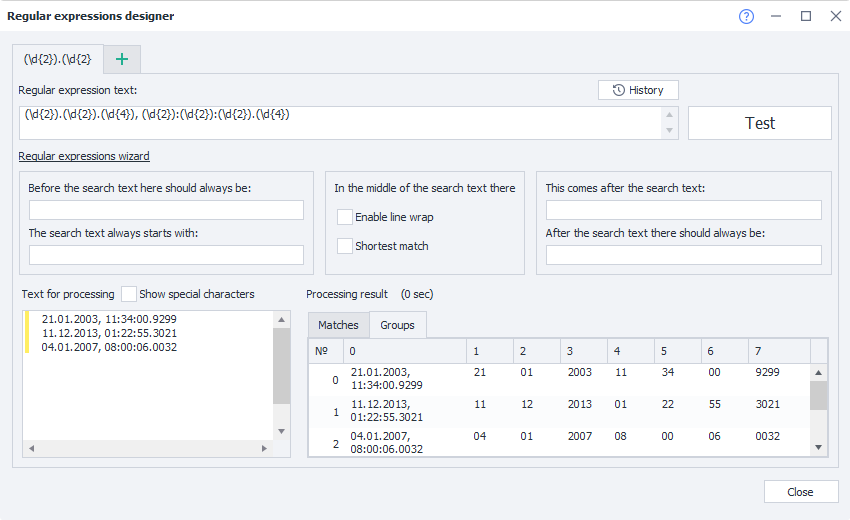
Now let's take the day, month, and year from the second line and save them to variables. Here's how:
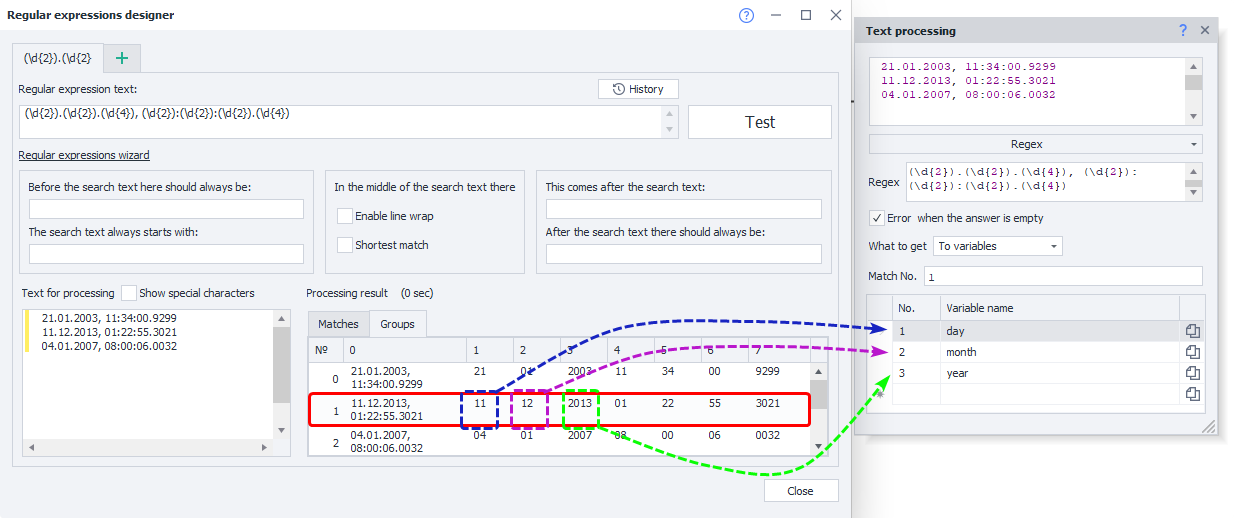
Match number is the line number. Since numbering starts at zero, write 1 for the second line.
Then specify the group number and variable to save each result to. Group 0 is the entire matched line: 11.12.2013, 01:22:55.3021. So for the individual bits, use groups: 1 for day, 2 for month, 3 for year.
To Table
Pretty similar to the previous feature, except here you save all results to a table, not just one. And you can exclude some groups from the final result.
Example here as well.
Let's use the same text:
21.01.2003, 11:34:00.9299
11.12.2013, 01:22:55.3021
04.01.2007, 08:00:06.0032
And the same regex:
(\d{2}).(\d{2}).(\d{4}), (\d{2}):(\d{2}):(\d{2}).(\d{4})
Here's the result in the Regex Tester:

For the final table, let's say you don't need seconds and milliseconds:

Group 0 is the whole matched line, so skip it. Also ignore groups 6 and 7 (seconds and milliseconds).
Example of Using Regex
Here's how you could extract links using regular expressions that you build in the ** constructor**.
Goal: Get profile links for active users on the ZennoLab forum
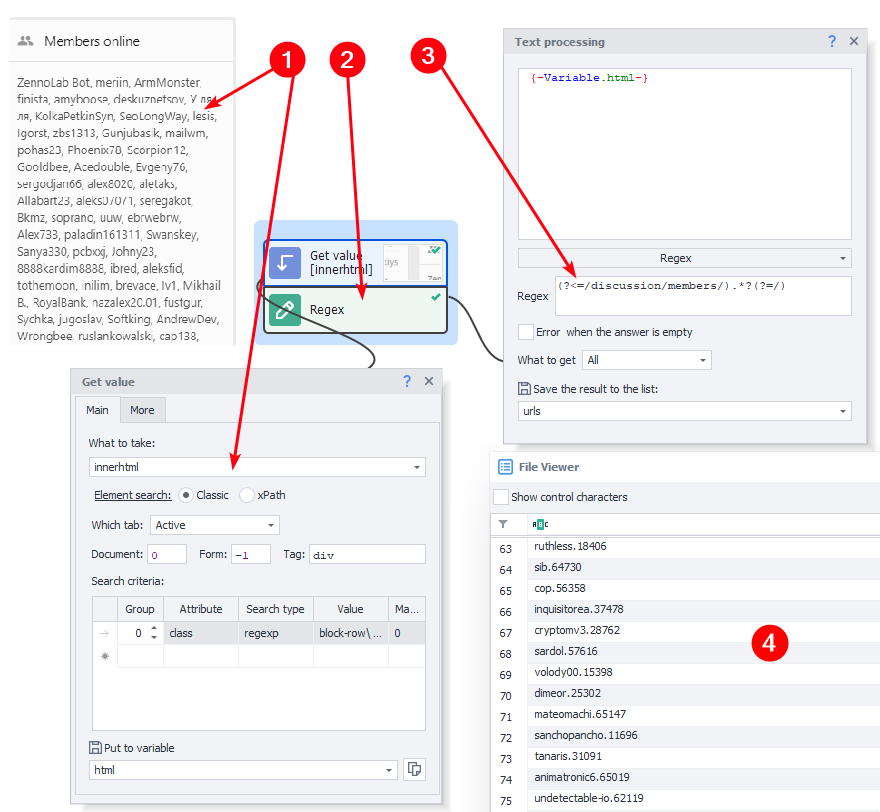
1. Using the Get Value action, get the HTML code that contains links to online users.
2. Add the Regex action. Build your pattern in the Regex Constructor.
3. In the action properties, put the html variable as input, and save results to the urls list.
4. After running, you'll get a list of unique IDs which you can use to build user profile URLs.
Spintax (Randomizing and Varying Text)
With this tool, you can automatically create synonymized texts. It uses curly braces and vertical slashes to mix things up in random order.
A simple spintax looks like: {option1|option2|option3}. When run, one of the three options is randomly picked. Spintax can get much fancier with multi-level nesting — so you can easily generate thousands of variations from one template.
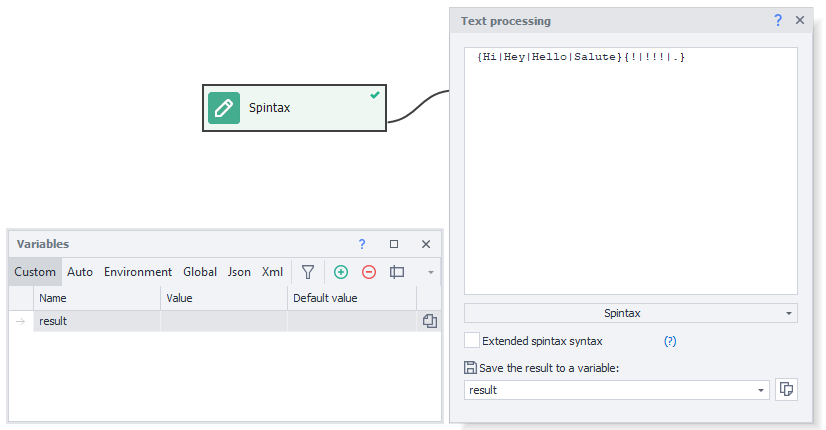
Extended Syntax
{Red|White|Blue}— the result will be one value, like White.[ Red| White| Blue]— the values will be shuffled: White Blue Red.[+_+Red|White|Blue]— the values will be shuffled but with a separator between them: White_Red_Blue.
You can nest as much as you like: [+{_|-}+Red|White|Blue {1|2}] = White-Blue 2-Red
Special symbols can be escaped for clarity: [+\++Red|\[White\]|Blue] = [White]+Red+Blue
Split (Splitting Text)
Splitting is done using a specific symbol (delimiter). Afterward, you'll get an array out of your string. This is a simpler alternative to using RegExp for splitting by characters.
Separators
Here you enter which symbols to split the data by.
Allow Empty Values
Easier to show with an example:

Say you've got a line like: name;surname;sex;birth year. If you skip one value, like no gender: Andrey;Pavlov;;1988, then 1988 goes into the sex variable, not year, which might not be what you want.
To fix this, enable Allow empty values. Then you can have empty strings written to variables where needed.
Example of Split
Let's break down proxy lines into parts.
Bought proxies usually look like this: login:pass@host:port. So you're splitting by both : and @. Your action block settings might look like this:
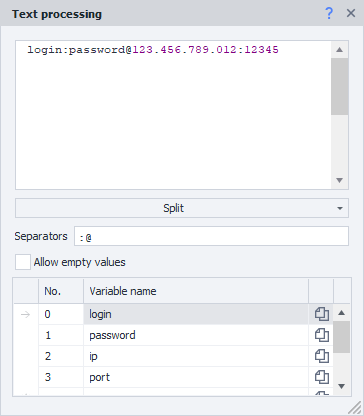
ToChar (Converting Integers to Unicode)
Every Unicode symbol has its own numeric code. So you can convert any number to its assigned symbol. For example, the code for ♛ is 9819.
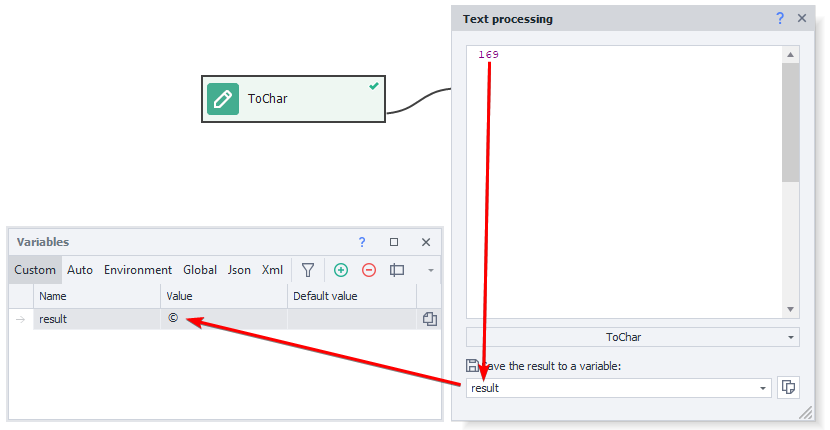
ToLower (To Lowercase)
This action makes letters lowercase depending on the setting you choose.
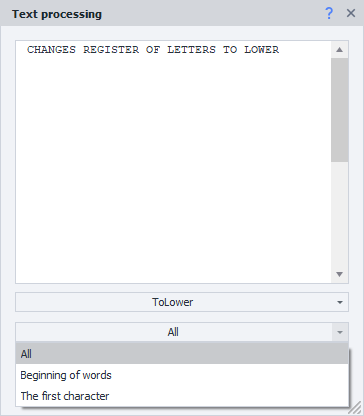
All
Changes every uppercase letter in the text to lowercase.
| Was | Now |
|---|---|
| CHANGES REGISTER OF LETTERS TO LOWER | changes register of letters to lower |
Beginning of words
Only the first character of every word is made lowercase.
| Was | Now |
|---|---|
| CHANGES REGISTER OF LETTERS TO LOWER | cHANGES rEGISTER oF lETTERS tO lOWER |
The first character�
Only the first character of the first word is made lowercase.
| Was | Now |
|---|---|
| CHANGES REGISTER OF LETTERS TO LOWER | cHANGES REGISTER OF LETTERS TO LOWER |
ToUpper (To Uppercase)
This action makes every letter uppercase as per the setting.

All
Changes all lowercase letters to uppercase.
| Was | Now |
|---|---|
| lowercase text | LOWERCASE TEXT |
Beginning of words
Only the first letter of each word is capitalized.
| Was | Now |
|---|---|
| lowercase text | Lowercase Text |
The first character
Only the first character of the first word is capitalized.
| Was | Now |
|---|---|
| lowercase text | Lowercase text |
Trim (Remove Characters at Start/End of String)
Use this function to remove unwanted characters at the start and/or end of a given string.
It often saves the day when you need to clear away extra spaces, line breaks or tabs left after parsing.
What to trim
Pick which characters to delete — choose a preset for all whitespace, or specify your own.
Where to trim
Decide where to delete characters:
- Start of string
- End
- Start and End
UrlDecode (Decoding)
Decodes a string previously encoded with UrlEncode (described below).

The effect is easiest to see with Cyrillic:
Before: %D0%9F%D1%80%D0%B8%D0%B2%D0%B5%D1%82%2C%20%D0%BC%D0%B8%D1%80%21
After: Привет, мир!
UrlEncode (Encoding)
A URL only allows Latin letters, numbers, and a handful of punctuation marks. All other symbols in HTTP requests must be encoded with UrlEncode or the server won't understand your request.
Encode Only Variable Values
This option is useful when building HTTP requests because you only need to encode parameters, not the site address.
Settings might look like this:

In {-Variable.keyword-} you have the text что такое urlencode, and after encoding, {-Variable.url-} will hold:
https://www.google.com/search?q=%d1%87%d1%82%d0%be+%d1%82%d0%b0%d0%ba%d0%be%d0%b5+urlencode
To Variable
This action just saves everything you put in the input window — variables, text, symbols, project constants — into a single variable.

To List
This action splits your text into lines using the chosen delimiter, then puts them in a list.

Separator
- Enter. New line.
- Space
- Custom text. You can specify a single character (like
;) or several (they'll be treated as one delimiter!). - Custom Regex. Use a regex as your splitter.
To Table
This action splits your text into lines and columns using the delimiters you specify, then fills out a table.
Separator
- Enter. New line.
- Space
- Custom text. Specify as for lists (several symbols treated as one!).
- Custom Regex. Use your own regexp.
Replace
This action replaces one string with another and saves the result to a variable.

What to Search
Specify the string or a regex if you select that mode.
What to Replace With
What text should replace what you found in the previous step.
Search Type
- Text. Looks for the exact text you type.
- Regex. Here, you give a pattern and it'll replace matches.
What to Replace
First
Only replaces the first found match.
All
Replaces all matches at once.
One Match
In this case, only the specified match (or last match) is replaced.
Match Numbers
Enter which matches to replace as a comma-separated list (zero-based numbering).
Translation
This action translates strings from one language to another.

Translation Service
Several options are available, which helps make text high-quality and unique.
API keys for these services must be added via Program Settings

Source Language / Target Language
Here you specify which language to translate from and to.
The system will try to detect the source language automatically, but can't guarantee the result.
You should enter the language code, not its full name. Examples:
- English: en
- Spanish: es
- German: de
- Russian: ru
- And so on. Full list.
For the most accurate list, always check your chosen service's docs.
Prepare JavaScript
This action processes a string for safe use in JavaScript. It mainly escapes quotes, apostrophes, and other special symbols so your text can be used in JavaScript and IF actions.
Before: <a href="https://zennolab.com/">
After: <a href=\"https://zennolab.com/\">
Substring
Takes a specific section out of a string. Give it the From and To character numbers.

In this example, we're taking a substring from character 95 to end of string, getting "до другого.".
Transliteration
On rare occasions, you might still need to convert Cyrillic into Latin characters. This action does that.
